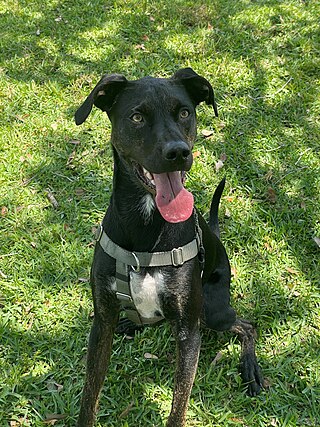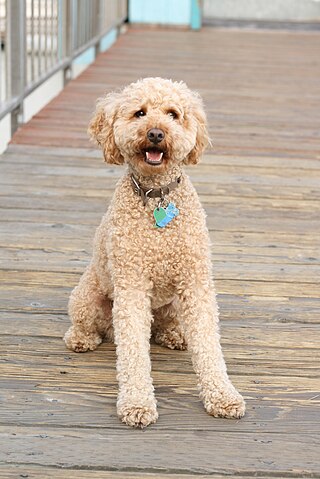
A dog breed is a particular type of dog that was purposefully bred by humans to perform specific tasks, such as herding, hunting, and guarding. Dogs are the most variable mammal on Earth, with artificial selection producing upward of 360 globally recognized breeds. These breeds possess distinct traits related to morphology, which include body size, skull shape, tail phenotype, fur type, body shape, and coat colour. However, there is only one species of dog. Their behavioral traits include guarding, herding, and hunting, and personality traits such as hyper-social behavior, boldness, and aggression. Most breeds were derived from small numbers of founders within the last 200 years. As a result of their adaptability to many environments and breedability for human needs, today dogs are the most abundant carnivore species and are dispersed around the world.

The American Kennel Club (AKC) is a registry of purebred dog pedigrees in the United States. In addition to maintaining its pedigree registry, this kennel club also promotes and sanctions events for purebred dogs, including the Westminster Kennel Club Dog Show, an annual event which predates the official forming of the AKC, the National Dog Show and the AKC National Championship. The AKC is a non-member partner with the Fédération Cynologique Internationale. The AKC recognizes 200 dog breeds, as of 2022.

The Rhodesian Ridgeback is a large dog breed originally bred in Southern Africa. The original breed standard was drafted by F.R. Barnes, in Bulawayo, Southern Rhodesia, in 1922, and approved by the South African Kennel Union in 1927. Its forebears can be traced to the semi-domesticated ridged hunting and guardian dogs of the Khoikhoi. These were interbred with European dogs by the early colonists of the Cape Colony for assisting in the hunting of lions.

The Boxer is a medium to large, short-haired dog breed of mastiff-type, developed in Germany. The coat is smooth and tight-fitting; colors are fawn, brindled, or white, with or without white markings. Boxers are brachycephalic, have a square muzzle, mandibular prognathism, very strong jaws, and a powerful bite ideal for hanging on to large prey. The Boxer was bred from the Old English Bulldog and the now extinct Bullenbeisser, which became extinct by crossbreeding rather than by a decadence of the breed. The Boxer is a member of both The Kennel Club and American Kennel Club (AKC) Working Group.

The Saarlooswolfdog is a wolfdog breed originating from the Netherlands by the crossing of a German Shepherd with a Siberian grey wolf in 1935. The offspring were then further crossed with German Shepherds.

A labradoodle is a crossbreed dog created by crossing a Labrador Retriever and a Standard or Miniature Poodle. Labradoodles were intended to be a good choice for people with canine dander allergies.

A mongrel, mutt, or mixed-breed dog is a dog that does not belong to one officially recognized breed, including those that result from intentional breeding. Although the term mixed-breed dog is sometimes preferred, many mongrels have no known purebred ancestors.

A kennel club is an organization for canine affairs that concerns itself with the breeding, showing and promotion of more than one breed of dog. Kennel clubs became popular in the mid 19th century. All-encompassing kennel clubs are also referred to as 'all-breed clubs', although "all" means only those breeds that they have decided to recognize, and "breed" means purebred dogs, not including dog hybrids and crossbreeds or mixed-breed dogs. A club that handles only one breed is known as a breed club.

Dog crossbreeds, sometimes called designer dogs, are dogs which have been intentionally bred from two or more recognized dog breeds. They are not dogs with no purebred ancestors, but are not otherwise recognised as breeds in their own right, and do not necessarily breed true.
Purebreds are "cultivated varieties" of an animal species achieved through the process of selective breeding. When the lineage of a purebred animal is recorded, that animal is said to be "pedigreed". Purebreds breed true-to-type which means the progeny of like-to-like purebred parents will carry the same phenotype, or observable characteristics of the parents. A group of purebreds is called a pure-breeding line or strain.
A crossbreed is an organism with purebred parents of two different breeds, varieties, or populations. Crossbreeding, sometimes called "designer crossbreeding", is the process of breeding such an organism. While crossbreeding is used to maintain health and viability of organisms, irresponsible crossbreeding can also produce organisms of inferior quality or dilute a purebred gene pool to the point of extinction of a given breed of organism.
A breed registry, also known as a herdbook, studbook or register, in animal husbandry, the hobby of animal fancy, is an official list of animals within a specific breed whose parents are known. Animals are usually registered by their breeders while they are young. The terms studbook and register are also used to refer to lists of male animals "standing at stud", that is, those animals actively breeding, as opposed to every known specimen of that breed. Such registries usually issue certificates for each recorded animal, called a pedigree, pedigreed animal documentation, or most commonly, an animal's "papers". Registration papers may consist of a simple certificate or a listing of ancestors in the animal's background, sometimes with a chart showing the lineage.

The Olde English Bulldogge is an American dog breed, recognized by the United Kennel Club (UKC) in January 2014. The breed is listed in the UKC Guardian Dog Group. Five years prior to UKC recognition, the breed was registered by the former Canine Developmental, Health and Performance Registry (CDHPR), a privately held business located in Kalamazoo, Michigan. In the early 2000s, CDHPR had been working with the UKC under a unique agreement to develop breeding plans and strategies in an effort to produce improved breeds of dogs that would be accepted as purebred and, therefore, eligible for UKC registration.

The Dobermann is a German breed of medium-large domestic dog of pinscher type. It was originally bred in Thuringia in about 1890 by Louis Dobermann, a tax collector. It has a long muzzle and – ideally – an even and graceful gait. The ears were traditionally cropped and the tail docked, practices which are now illegal in many countries.
Canine reproduction is the process of sexual reproduction in domestic dogs, wolves, coyotes and other canine species.

Pedigree Dogs Exposed is a BBC One investigative documentary, produced by Jemima Harrison, which looks into health and welfare issues facing pedigree dogs in the United Kingdom. It was originally broadcast on 19 August 2008.
The Kennel Club of India is a registry of purebred dogs in India. As well as maintaining a registry of pedigrees, the club promotes and sanctions events for purebred dogs, including annual dog shows and specialty shows. The Kennel Club of India is a member of the Fédération Cynologique Internationale.

The popular sire effect occurs when an animal with desirable attributes is bred repeatedly. In dog breeding, a male dog that wins respected competitions becomes highly sought after, as breeders believe the sire possesses the genes necessary to produce champions. However, the popular sire effect is not just down to wanting to produce a champion. For example, in Staffordshire Bull Terriers there are several popular sires who are used by breeders to produce specific colours that are not favoured in the show ring. The popular sire is often bred extensively with many females. This can cause undetected, undesirable genetic traits in the stud to spread rapidly within the gene pool. It can also reduce genetic diversity by the exclusion of other males.
Purebred breeders are dog breeders that intentionally breed purebred dogs specifically to continue the lineage of certain breed characteristics in dogs by mating selected canines.
Pedigree Dogs Exposed: Three Years On is a 2012 follow-up to the 2008 BBC One documentary, Pedigree Dogs Exposed (PDE). While this second programme looks at the positive changes made since the original film, it focuses on investigating areas of continuing concern. The programme concluded that it was time to call a halt to suffering created by breeders. It states that as long as the Kennel Club (KC) tolerated human whim leading to dogs that cannot run, breathe, or see freely, dogs would continue to suffer, but featured that, in fact, the Kennel Club would continue in the vein, suggesting that the organisation has a conflict of interest in juggling its commitments to breeders and to dogs – when the interest of dogs does not match up with that of breeders, the dogs suffer. It also called on dog fanciers to stop being consumers of 'freak-show" appearance, the driving factor in developing dogs to physical extremes. KC refused to participate in the production. The programme aired on 27 February 2012 in the United Kingdom.


















